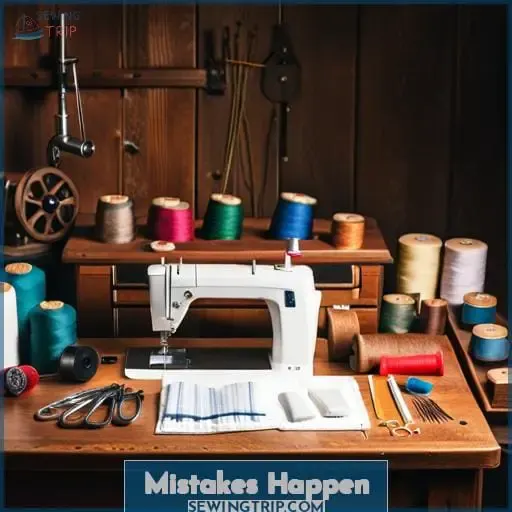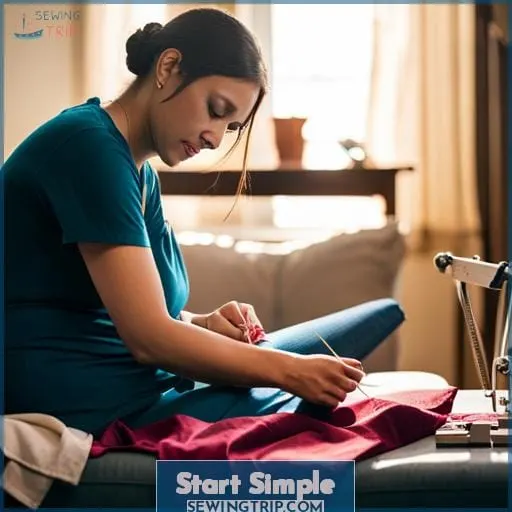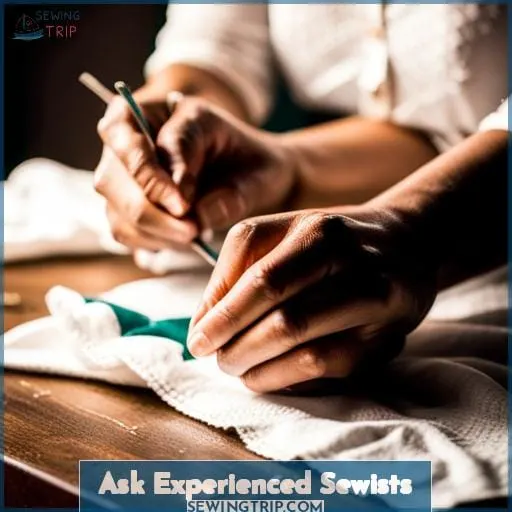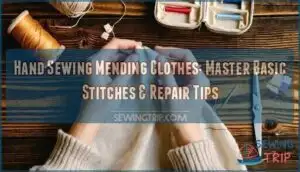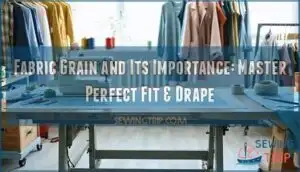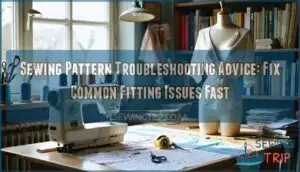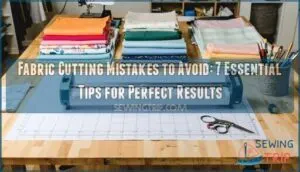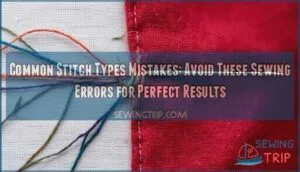This site is supported by our readers. We may earn a commission, at no cost to you, if you purchase through links.
 Y’all, learning to sew ain’t as easy as threading a needle! Believe me, I speak from experience.
Y’all, learning to sew ain’t as easy as threading a needle! Believe me, I speak from experience.
When I first started, I was clueless about even the most basic stuff. So here’s some hard-earned advice from someone who’s been there:
Slow your roll. Sewing takes patience – don’t expect perfection right off the bat.
Ask for help when you need it; most sewists are happy to lend a hand to newbies. And pro-tip: invest in a few key tools like a seam ripper and walking foot early on.
Most importantly, start simple and have fun! Sewing is creative, empowering, and oh so satisfying once you get the hang of it.
Trust me, with some perseverance and these 14 things I wish I knew when learning to sew, you’ll be cranking out projects in no time.
So grab some fabric and let’s do this thing together!
Table Of Contents
Key Takeaways
- Invest in quality tools like seam rippers and walking feet early on to make learning easier.
- Start with simple projects using easy fabrics like cotton to master fundamentals before advancing.
- Don’t compare your work to experienced sewers’; stay focused on your own development.
- Embrace mistakes as part of the learning process and persist through inevitable challenges.
Essential Tools
A seam ripper is indispensable for removing stitches. The well-reviewed Lhedon model is a great option. A walking foot helps feed fabric smoothly. Consider the open toe Brother model, which provides visibility.
With practice and the right tools, your sewing skills will steadily improve. The proper equipment makes a difference. A quality seam ripper like the Lhedon lets you undo mistakes. A walking foot such as the open toe Brother ensures even fabric feeding.
Over time, as you gain experience, your technique will continue to progress. Start with high-quality tools, practice regularly, and be patient. Your sewing abilities will become better and better. The right tools paired with dedication will lead to success.
Seam Ripper
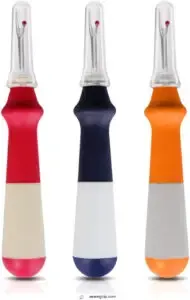
Grab that Lhedon seam ripper when you’ve sewn a seam crooked and need to rip it out quick. The ergonomic handle provides a sturdy, comfortable grip so your hand won’t cramp, while the sharp precision blades slice through fabric with ease.
Made of durable stainless steel and hard plastic, this affordable little tool tackles ripping and cutting tasks for quilters, sewists and crafters alike.
- Ergonomic handle for comfort
- Sharp blades easily cut stitches
- Built-in thread cutter
- Durable materials
- Affordable price
- No cover included
- Handwash care required
- Made in China
Walking Foot
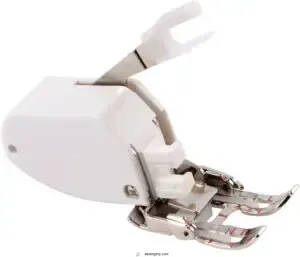
Attach that open toe walking foot when you’ve gotta keep slippery fabrics feeding straight.
- Helps prevent thin fabrics like silk and satin from slipping and shifting.
- Makes sewing thick seams and multiple layers easier.
- Allows you to maintain consistent stitch length on all fabric types.
This special presser foot helps fabrics feed evenly by providing equal pressure from top and bottom. It’s great for preventing lightweight fabrics from shifting side to side or slipping down into the machine.
The included guide keeps your work on track for straight stitching too. It’s just what you need when finicky fabrics misbehave.
Mistakes Happen
Don’t fear making the first cut into new fabric. Mistakes are inevitable for new sewists, so be patient and focus on the learning process rather than comparing yourself to others. Carefully pin fabric pieces together to test the fit before sewing. Adjust patterns as needed and mark any problematic areas.
Sew slowly, double-checking measurements and seam allowances. If mistakes happen, carefully unpick the stitches and redo sections as needed.
It’s all part of learning. With practice, you’ll gain confidence and skills. Sewing may not be easy peasy at first, but with an adjusting, learning mindset, your abilities will steadily improve project by project.
Take Your Time
It’s normal to take your time as a beginner sewist. Don’t rush the process. Instead, enjoy learning at your own pace. Comparisons to others will only discourage you. For new sewists, sewing skills develop through patience and practice over a long period of time.
Don’t fear the inevitable periods of self-doubt; simply try again. In time, your abilities will steadily improve project by project as long as you stay focused on your own growth.
Start Simple
Begin with simple patterns as you’re developing your sewing skills. Don’t be tempted to jump into elaborate designs before you’ve mastered the basics. Simple projects will help you get comfortable with your machine, learn how fabric behaves, and practice key techniques without getting overwhelmed.
Test different fabrics to see how they sew. Try hand sewing to get the feel of stitching. Mark seam lines and pin patterns to avoid mistakes. Use fewer pins until you gain precision.
Restart with a new needle and presser foot for each new fabric to avoid issues. Don’t waste time comparing your early work to experienced sewers.
Allow yourself to learn at your own pace through practice. Every project advances your skills.
Ask Experienced Sewists
You’re eager to progress but still learning the basics. That’s normal. Now’s the time to get curious and acquire advice from experienced sewers. Ask questions about grainlines, the fitting process, sewing different fabrics. Stay open-minded to light bulb moments shared.
Approach fellow sewers humbly, without judgment. Let their wisdom guide you. Absorb their tips through ongoing dialogue, not just once. Let their experience shorten your learning curve. They’ll enjoy mentoring you, so don’t be shy.
With patience and practice, their knowledge can unlock your potential. Just keep asking questions.
Frequently Asked Questions (FAQs)
What are some good beginner sewing projects to start with?
Start simple yet meaningful. Pillows teach cutting, seams, corners. Pajamas allow perfecting fit and following patterns. Aprons develop an understanding of construction. Pick projects suiting your skill level.
How do I choose fabric for my sewing projects?
Choose fabric that’s easy to work with as you’re learning. Let the project guide the fabric selection, not the other way around. Start with cottons and lighter weight wovens. Avoid slippery, sheer fabrics for now.
Focus on learning techniques, not fighting fabric. Cotton makes learning easier.
What sewing machine features are most important for a beginner?
The basics should be the priority. Straight and zigzag stitch capabilities are more important initially than decorative stitches or speed controls. Focus first on mastering fundamentals before moving on to trickier techniques and fabrics.
Where can I find sewing patterns for clothes and home decor?
You can find sewing patterns at fabric stores, online retailers like Etsy, major pattern brands, thrift stores, or for free online if you search for free sewing patterns. Before purchasing, check pattern reviews to make sure it’s a good fit for your skill level and project goals.
For beginners, it’s often best to start with simple patterns and work your way up to more advanced projects. Take time to carefully read the pattern instructions so you understand what skills, tools and materials are needed.
How often should I change the needle on my sewing machine?
You should change your sewing machine needle every 8-10 hours of sewing time. This prevents skipped stitches, thread breaks, and damage to fabrics.
Conclusion
Trust the process, dear sewer; while the fabric may fray, you grow. With guidance from the seasoned and patience within, the dream dress emerges one stitch at a time. We learn the most when learning to sew, so embrace each mistake, and know things I wish I knew when learning to sew.

